Copp's Hill Burying Ground
Introduction
Text-to-speech Audio
Images
Copp's Hill Burying Ground marker (image from Historic Markers Database)
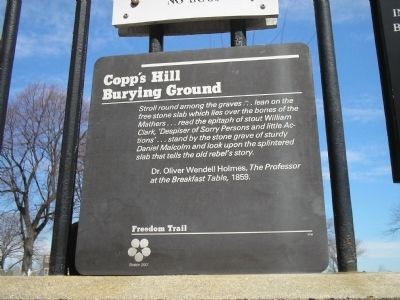
Mather family tomb (image from Historic Markers Database)
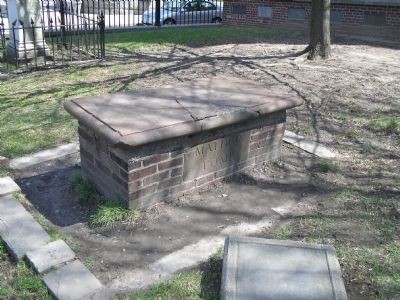
Gravestone of Captain Daniel Malcom, allegedly used for target practice by British soldiers (image from Historic Markers Database)
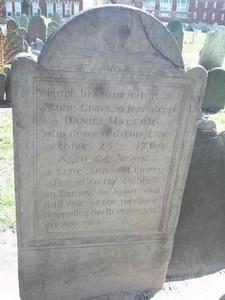
Grave of Robert Newman, who signaled Paul Revere on April 18, 1775 (image from Historic Markers Database)
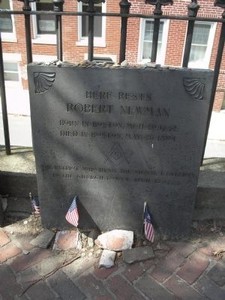
Gravestone of Prince Hall, a freed slave and activist, and founder of the first lodge of Black Freemasons, the African Lodge of the Honorable Society of Free and Accepted Masons of Boston (image from Historic Markers Database)
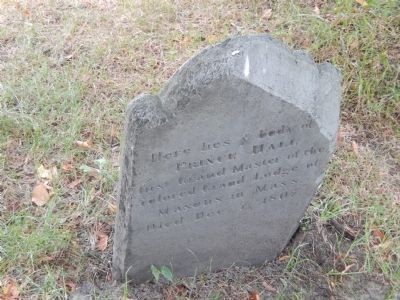
Prince Hall Memorial, erected June 24th, 1895 by the Prince Hall Masons (image from Historic Markers Database)
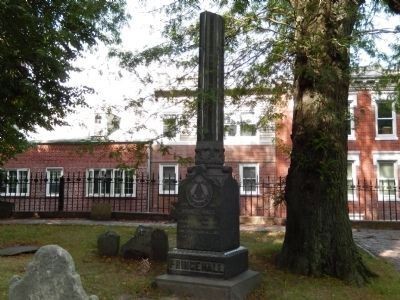
Copp's Hill Burying Ground in the 1890s (image from the Boston Public Library)
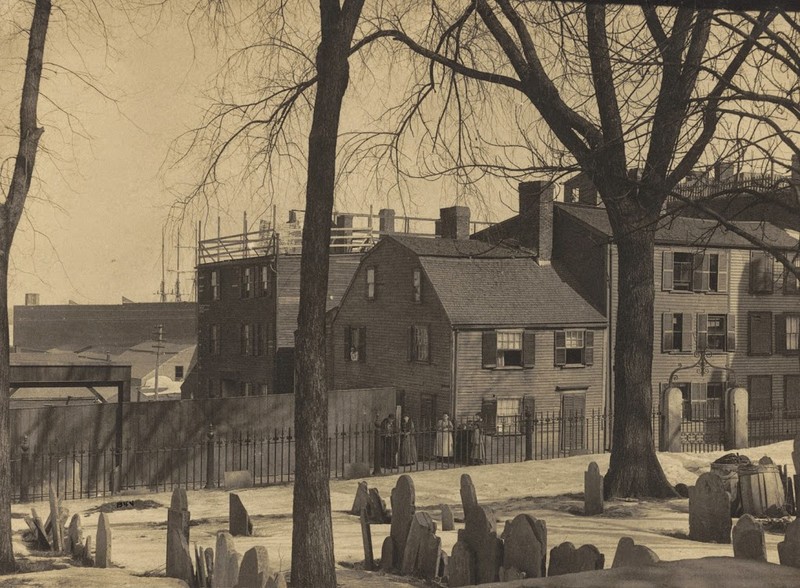
View of Boston Harbor from Copp's Hill in 1898 (image from the Boston Public Library)
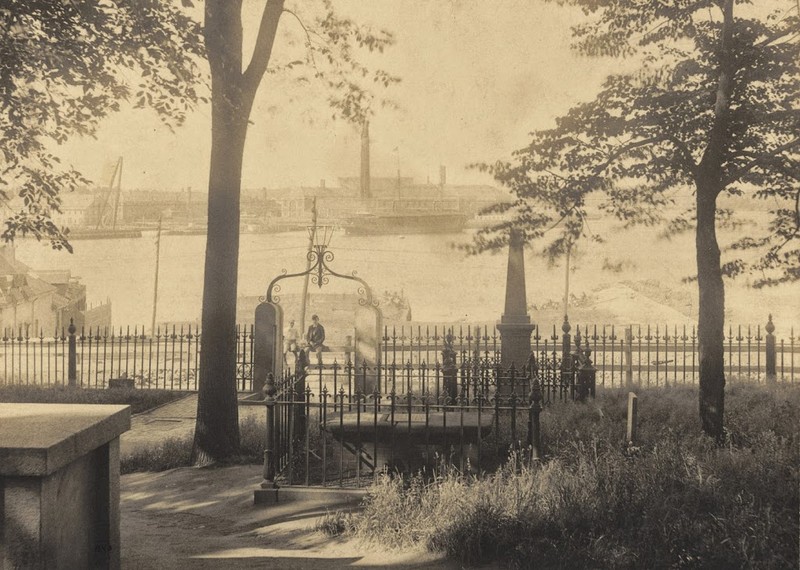
Copp's Hill Burying Ground in 1904 (image from Lost New England)
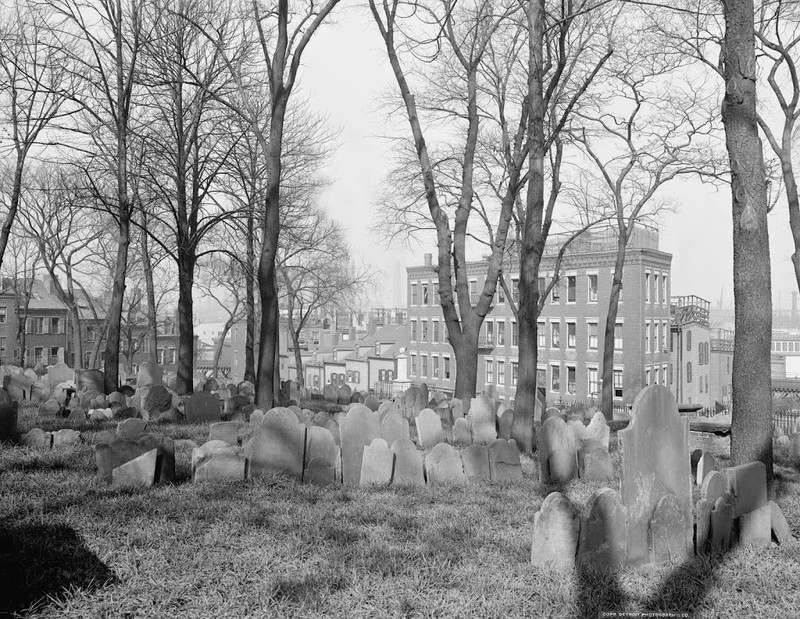
Copp's Hill Burying Ground in 2014 (image from Lost New England)
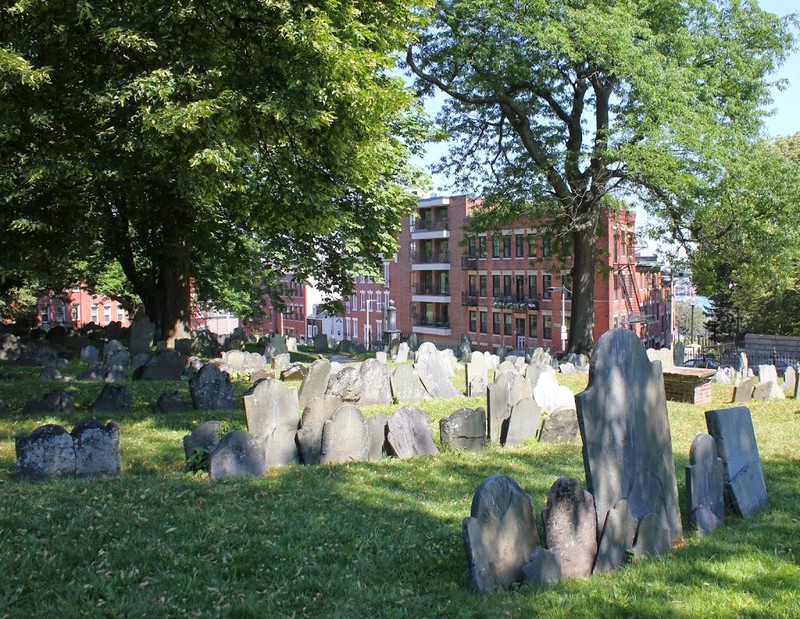
Copp's Hill Burying Ground and Old North Christ Church, Hull Street and Salem Street, Boston (image from Digital Commons)
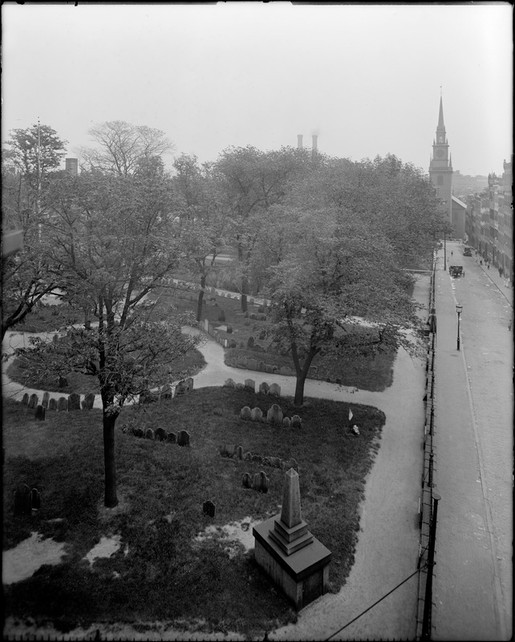
Mapped locations of historical markers and interpretive signage in Copp's Hill Burying Ground (map from Historic Markers Database)
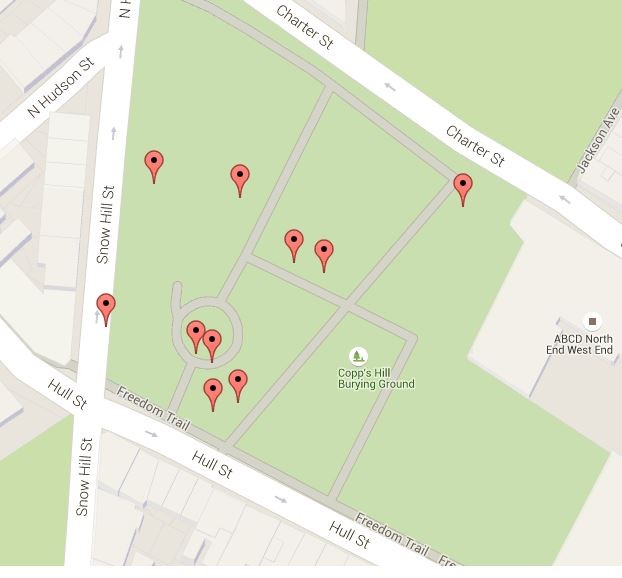
Backstory and Context
Text-to-speech Audio
Copp's Hill Burying Ground is Boston's largest and second oldest Colonial cemetery. Only three acres in size, it holds an estimated 10,000-11,000 burials dating between 1660 and 1968. Of the 2,200 surviving gravestones, 60% date to before the American Revolution. Now owned by the City of Boston Parks and Recreation Department, it is part of the Historic Burying Grounds Initiative and the Freedom Trail, a 16-site trail of 2.5 miles marked in red with daily public tours and downloadable audio tours. Among the graves at Copp's Hill are the Puritan Mather family ministers, who are associated with the Salem witch trials; 29 Boston Tea Party participants; 43 Revolutionary War veterans including anti-slavery activist and founder of the Black Masonic Order, Prince Hall; Revolutionaries Robert Newman and Daniel Malcom; Edmund Hartt, who built the frigate U.S.S. Constitution; artisans, merchants, slaves, and free African Americans.
The slope on which Copp's Hill Burying Ground is now located was known in the 1630s as Windmill Hill, after settlers of the Shawmut Peninsula (now Boston) built a wind-powered grain mill on the peak. Later known as Snowhill, the land was first used as a cemetery in 1659, when Boston's first cemetery (Central Burying Ground, now known as King's Chapel) became overcrowded. The grounds were expanded in 1711, 1809, and 1825. The oldest surviving headstone (1661) is the double grave of two grandsons of William Copp, the cobbler for whom the cemetery was eventually named. William Copp had settled on Windmill Hill circa 1635. The cemetery was originally called North Burying Ground, and its first interments came primarily from North End artisans, merchants, and free African Americans from the New Guinea community. Though Boston was one of the largest New England slave ports during the 17th and 18th centuries, the free African American community began around 1650 at the base of Copp's Hill. It is estimated that over 1,000 graves in the cemetery belong to people of African descent, including the grave of Prince Hall, who led the community in petition to end slavery in the state of Massachusetts in the 1760s, a goal which was achieved within two decades.
Since Copp's Hill overlooked the wharves and the riverfront facing Charleston and Chelsea, the burying ground was a strategic location during the Revolution. Days after the battles of Lexington and Concord, on April 23, 1775, British Admiral Samuel Graves took over Copp's Hill, building a battery and earthworks above the burying ground on the western slope. From there, British cannons opened fire on the town of Charleston on June 17, 1775 in the Battle of Bunker Hill.
The Copp's Hill Burying Ground was altered in the 1830s,
when the cemetery department installed paths, walls, steps, trees, and small
buildings to the grounds, transforming it into a park-like setting. During the
process, headstones were moved into neat rows, which no longer necessarily mark
the physical graves.
Copp’s Hill Burying Ground
Freedom Trail
Stroll round among the graves . . . lean on the free stone slab which lies over the bones of the Mathers . . . read the epitaph of stout William Clark, ‘Despiser of Sorry Persons and little Action’ . . . stand by the stone grave of sturdy Daniel Malcolm and look upon the splintered slab that tells the old rebel’s story. / Dr. Oliver Wendell Holmes, the Professor at the Breakfast Table, 1859.
Copp's Hill Burying Ground
In the 1630s, the northern-most slope of the Shawmut
Peninsula (or Boston) was a prominent landmark. Settlers soon discovered its
strategic overlook of the Harbor and of the Charles River to the west and found
the steep hillock well-protected from the “three great annoyances, of Woolves,
Rattle-snakes and Musketos.” The settlers first built a wind-powered grinding
mill here and called the slope, Windmill Hill. Later it was known as Snowhill
and finally Copp's Hill.
William Copp, after whom the hill and burying ground are named, was a cobbler
who once owned the land here. The gravestones of his children, buried in the
1660s, are still here at the hill's crest. Other settlers were buried nearby
when the Town bought the site in 1659 and called it the North Burying Ground.
Over the years, three sections were added to the original, although today they
appear as one.
During the occupation of Boston, British troops manned a battery at Copp's Hill
and rained fire onto nearby Charlestown during the Battle of Bunker Hill on
June 17, 1775.
Welcome to Copp’s Hill Burying Ground
About the Burying Ground
Copp’s Hill Burying Ground is the second oldest cemetery in Boston. In 1659,
town officials became concerned about overcrowding at the Central Burying
Ground (now called King’s Chapel Burying Ground on Tremont Street.) Land was
bought on Mill Hill in the North End for the new North Burying Ground, later
named Copp’s Hill Burying Ground. The cemetery you see today was purchased in
four installments:
1659: The first parcel of land was over the crest of the hill toward the
Charles River bordering Charter Street and Snow Hill Street (Sections A, B, C
and H on the plan.) You will notice that most of the 17th century burials are
in this part of the burial ground.
1711: The town expanded the burying ground to Hull Street by buying land
from Samuel Sewall (Sections D, E, F and G.) Hull Street was laid out in 1701
and named after silversmith John Hull, Samuel Sewall’s father-in-law.
1809: The town purchased Section J from Benjamin Weld for $10,000. This
section is surrounded by a row of tombs.
1825: The City of Boston annexed Section I, called the Charter Street
Burying Ground, from Mayor Charles Wells. Wells constructed 34 tombs on this
portion of the burying ground.
Today: The burying ground is owned by the City of Boston Parks & Recreation Department and maintained by the Cemetery Division in partnership with the Historic Burying Grounds Initiative.
About Copp’s Hill
In 1630, when John Winthrop’s fleet arrived in Boston Harbor, three high hills
dominated the tiny peninsula of land they called “Boston Town;” Fort Hill, in
the south end of town near Rowe’s Wharf; the Trimountain, now Beacon Hill, in
the center; and Copp’s Hill at the north end. This hill was approximately 10
feet higher in 1630 than it is today, having been cut down in the early 19th
century to fill in the Mill Pond near what is now North Station.
The hill was first called Wind Mill Hill or Mill Hill because a windmill for
grinding grain was constructed at the top in 1632. Later it became known as
“Copp’s Hill,” named after William Copp and his family who settled on the hill
around 1635.
Copp’s Hill Facts
• It is estimated that 10,000 – 11,000 burials took place at Copp’s Hill
between 1660 and 1968.
• On June 30th, 1704, seven pirates were hung at Copp’s Hill (then known as
Broughton’s Hill;) Crowds of people gathered on the hill and in boats on the
Charles River to watch the execution.
Seventeenth Century
Copp's Hill
The Kennebec Raid
Captain Thomas Lake (1615-1676) (C-143) was born in Tetney, County Lincoln, England in 1615 and settled in Boston in the 1650s. He and his partner, Thomas Clarke, set up trading posts in Maine, including one at Arrowsic Island near the mouth of the Kennebec River. Capt. Lake’s business prospered until the Native American uprisings of the 1670s. On Sabbath Day, August 20, 1676, Samuel Sewall wrote in his diary: “we heard amazing news of sixty persons killed at Quinebeck, by barbarous Indians, of which were Capt. Lake, Mr. Collicot, Mr. Padeshell.” During the attack Lake fled the trading post, but was later captured and killed. Capt. Lake’s body was found several months later, still frozen. In 1677 the remainder of his corpse was “honorably buried” at Copp’s Hill. Some say that the lead shot from his body was melted and poured into the gravestone.
"The Old Citizen"
Nicholas Upshall (d. 1666) (A-409) was an early settler of Boston and the proprietor of the Red Lion Inn in the North End. In the 1650s, Upshall became a Quaker and was banished from Boston for helping imprisoned Quakers Anne Austin and Mary Fisher. On his return only the intervention of his wife, Dorothy (Capen) Upshall (d. 1675) (C-38), kept him from long-term detention at Castle Island. Upshall was immortalized as the “Old Citizen” in Henry Wadsworth Longfellow’s Christus: A Mystery and in the poetry of Quaker John Greenleaf Whittier.
"The Greatest American Puritan"
Near the Charter Street entrance is the Mather Tomb (I-23), wherein lie the remains of the most celebrated family of Puritan ministers: Increase Mather (1639-1723), Cotton Mather (1663-1728), and Samuel Mather (1706-1785.) Increase Mather has been called “the greatest American puritan.” A graduate of Harvard in 1656, he was actively involved in the political and religious life of Massachusetts Bay in Boston and in the British Isles. His son Cotton followed him to Harvard and to the ministry of the Second Church in Boston. Cotton Mather was a prolific writer and commentator and is considered the “most famous of the puritan divines.” Samuel Mather, son of Cotton Mather, also graduated from Harvard and served at the Second Church, but left in 1742 to found and independent congregation.
The Oldest Gravestone
The earliest surviving gravestone is the double stone (C-264) of William Copp’s grandsons: David Copp, who was born and died in 1661, and Thomas Copp, who died in 1678 at age 3. The hill and the burying ground are named after their family.
Other early stones include Nathanial Saxton, who died in 1677 (C-270) at the age of 19; the double stone of John and Susannah Sweet (H-44); and the beautifully carved stone (C-30) of Grace Berry (d. 1695.)
The Mathers
Several generations of great 17th and 18th century New
England divines are buried here. Increase (1639-1723), the father; Cotton
(1663-1728), the son; and Samuel Mather (1706-1785) the grandson, belonged to a
remarkable family of ministers. At a time when the church wielded its own power
and religious zeal translated into political influence, the Mathers’
ecclesiastical attainments assured them secular authority.
Increase was the sixth son of Richard, who was first of the Mather dynasty and
a minister in Dorchester. Increase graduated from Harvard in 1656 and within a
decade began a 60 year ministry to the 2nd Church of Boston. Later, he was
named president of Harvard. As a powerful statesman, Increase represented
Massachusetts at the British Court and tried to secure a new, beneficial
charter for the Colony in the early 1690s. This effort and his role as personal
advisor to the new Royal Governor, Sir William Phips, attracted such resentment
that he was forced to resign as Harvard president and lose his political power.
Increase spent his last days in the North End where he had lived much of his
life and had raised his 10 children.
Unusual Gravestones
Fascinating people from Boston’s history lie in this burying
ground.
Look to the left for the double Worthylake gravestone, dating from 1718.
Worthylake was the first keeper of the Boston Light. He and his wife and
daughter drowned as they rowed to town from Noddle’s Island (now East Boston)
on a November day.
Wander down the path toward Snowhill Street and turn in, behind the tree on the
left, to find the Daniel Malcolm stone of 1769. This merchant of Fleet Street
opposed the British Revenue Acts by smuggling 60 casks of wine into Boston from
a ship. Legend says that British soldiers read his epitaph and then used the
stone for target practice, leaving bullet marks on it.
Now look for the granite pillar, a memorial to Prince Hall, whose simple
gravestone of 1807 is just behind. A Black freeman, Hall was “the first Grand
Master of the colored Grand Lodge of Masons” and one of many Black persons said
to be buried in this section of the graveyard. Before the Revolutionary War,
the Black community, known as New Guinea, was just below Charter Street.
Copp's Hill and the American Revolution
In the 18th century, Copp’s Hill was higher than it stands
today. On April 23, 1775, just a few days after the battles of Lexington and
Concord, British Admiral Samuel Graves received General Gage’s permission to
construct a redoubt on Copp’s Hill to protect his ships from rebel fire from
Charleston. His seaman dragged six 24-pound cannons up the hill and built a
temporary battery above the burying ground to the southwest (across the
intersection of Hull and Snow Hill streets.) At 9:00 am on June 17, 1775, the
Copp’s Hill battery opened fire on the Colonial forces across the harbor. Later
in the day, the battery was directed to fire “carcasses” (cannon balls
containing combustible fuel) at the town of Charleston, causing a fire that
destroyed the town.
General “Gentleman Johnny” Burgoyne watched the Battle of Bunker Hill from the
Copp’s Hill Battery and wrote that it was “one of the greatest scenes of war
that can be conceived . . . before us a great and noble town in one great blaze
– the church steeples, being timber, were great pyramids of fire above the
rest; behind us the church steeples and heights of our own camp covered with
spectators of the rest of our army which was not engaged; the hills around the
country covered with spectators . . . the roar of cannon, mortars and musquetry
. . . ”
Robert Newman, (1752-1806)
“One if by land, two if by sea”
The commemorative marker along the Snow Hill Street fence suggests that Robert Newman (W-22), breeches-maker and sexton of Christ Church (now Old North Church at the bottom of Copp’s Hill), is buried in Tomb 41. It was Newman who, at the age of 23, hung the lantern in the Christ Church steeple as a signal to Paul Revere and others on April 18, 1775.
Captain Daniel Malcom (1725-1769)
Legend states that the holes in Daniel Malcom’s stone (D-86) are from British soldiers at the Copp’s Hill battery conducting target practice against a “true son of liberty.” Captain Malcom was born in Maine and moved to Boston around 1750. A mariner, merchant and (according to the British) smuggler, he was one of the most vigorous opponents of the British Revenue Acts. In September of 1766, customs officers tried to search Malcom’s house and cellar for smuggled wine. Malcom “solemnly swore . . . if any man attempted to open it, he would blow his brains out.” When a mob formed, the customs officers withdrew. Malcom was also arrested for his part in unloading a cache of wine under cover of darkness from John Hancock’s sloop Liberty in April 1768. Capt. Malcom was a “Son of Liberty” and an active member of the Charitable Irish Society, serving as its Vice President at the time of his death. Ironically, his brother John Malcom was a customs officer, who was twice tarred and feathered. Daniel Malcom’s wife Ann (Fudge) Malcom (c. 1730-1770) (D-85) died only six months after her husband. Their gravestones were carved by their good friend, Capt. John Homer, whose cellar was raided by customs officers only a few weeks before Malcom’s death. Malcom’s father, Michael Malcom (d. 1775) (D-84), and possibly his sister, Sarah Malcom (d. 1767) (D-83), are buried next to them.
“Here lies buried in a Stone Grave 10 feet deep Capt. Daniel Malcom who departed this Life October 23d 1769 Aged 44 Years.
a true son of liberty
a Friend to the Publick
an Enemy to oppression
and one of the foremost
in opposing the Revenue Acts
on America”
Copp’s Hill Facts
• 60% of the gravestones date to before the American Revolution.
• It is believed that 29 participants in the Boston Tea Party may be buried at Copp’s Hill.
• At least 43 Revolutionary War veterans are buried at Copp’s Hill.
African Americans at Copp's Hill
The first mention of Africans arriving in Boston is in
Governor John Winthrop’s diary entry of February 26, 1638, in which he states:
“Mr. Peirce, in the Salem Ship, the Desire, returned from the West
Indies . . . and brought some cotton, and tobacco, and negroes, etc.” For the
next 145 years, the majority of Africans and African Americans who came to
Boston were brought in bondage as part of the region’s lucrative slave trade.
Boston was one of New England’s premier slave ports, importing African and West
Indian slaves for New England and the southern colonies.
By the 1700s, hundreds of slaves were being imported to Boston each year. In
the 1760s, the free African American community, under the leadership of Prince
Hall, petitioned to end slavery in Massachusetts. At the time, slaves across
the colony sued in court for their freedom. By the 1780s, slavery had ended in
Massachusetts. Many slaves, free African Americans, slave owners, and slave
traders are buried in Copp’s Hill.
Gravestones of African Americans
The free African American community started about 1650, when a small number of Africans secured their freedom. Freed men and women such as Sebastian Ken, Angola, and Zipporah Potter settled in Boston. It is said that many former slaves lived in the North End section called “New Guinea,” near the wharfs and shipyards around Copp’s Hill. More than 1,000 African Americans may be buried in Copp’s Hill, primarily in the area of Section A along Snow Hill Street that has fewer surviving gravestones. This may be because the stones were removed or lost, or the memorials were made of wood that has since decayed.
An example may be Thomas Paul (c. 1780-1831), the minister of the African Meeting House, on Beacon Hill from 1809 until his death in 1831. His obituary read in part, “His fame, as a preacher, is exceedingly prevalent; for his eloquence charmed the ear, and his piety commended itself to his hearers.” His death record states that he was buried at Copp’s Hill, but there is no marker. However, a prominent member of Paul’s congregation, Abel Barbados (-1817), has a grave marker (A02.)
Prince Hall (c. 1746-1807) (D-16 & D-17) was an important member of Boston’s African American community at the time of the American Revolution. After being freed from slavery in 1769, he assumed a leadership role in the African American community, drafting petitions for the abolition of slavery (1777), to protest the slave trade (1788), against the kidnapping of free Black men from Boston (1788), and objecting to the exclusion of African American children from schools (1787.) In 1775, he founded the African Lodge of the Honorable Society of Free and Accepted Masons of Boston, the first lodge of Black Freemasonry. When he died in 1807, it appears that he was buried near his first wife, Sarah Ritchie (d. 1769), as his name is inscribed on the back of her grave marker (D-16.) On June 24th, 1895, the Prince Hall Masons erected a monument to Prince Hall adjacent to the Richie marker.
Mary (Hammond?) Augustus (c. 1734-1759) (A-7) married Ceasor Augustus (Gustus) on November 28, 1757 at New South Church. Both she and Ceasor were listed as “free negroes.” Her epitaph reads: “Here lies the Body of Mary the Wife of Ceasor Augustus Servant of Mr. Robert Ball Aged 25 Years Died May 28, 1759.” Robert Ball (c. 1699-1774) (D-153) was a mariner and pilot, as well as keeper of Boston Light. He and his first wife, Martha (King) (c. 1683-1765) (D-151), are also buried at Copp’s Hill.
Copp’s Hill Facts
• It is believed that over 1,000 of the burials are people of African descent.
• Her gravestone epitaph is the only known record of the life of Margaret
Colbey (c. 1686-1761) (A-49.)
It reads “Here lies the Body of Margaret Colbey, a Free Negro Died May 4, 1761
aged 75 years.”
From Colonial Burying Ground to Victorian Park
When Copp’s Hill was first established as the “North Burying
Ground,” it was just below the summit of one of Boston’s highest hills. Looking
north over the colonial wharves one could see the towns of Charleston and
Chelsea and the confluence of the Charles and Mystic Rivers. There were no
trees in the burying ground, as all were cut down for buildings and firewood.
The gravestones were placed either in family groups or haphazardly throughout
the field. In the 1710s, the first tombs were built around the edge of the
grounds.
In the 19th century, burying grounds were transformed into “parks.” Many
families removed their ancestors to newer cemeteries, such as Mount Auburn and
Forest Hills. At Copp’s Hill in the 1830s, the cemetery department “organized”
the gravestones into rows; installed paths, steps and walls; and built a small
building where you are now standing. The “View of Copp’s Hill” published in
1851 shows Bostonians promenading through the burying ground. Additional
changes were made in 1878. Today, visitors can see portions of the Charleston
waterfront through the trees and buildings.
The Lighthouse Tragedy
In 1716, the first lighthouse in North America was built on Little Brewster
Island in Boston Harbor. George Worthylake (c. 1673-1718), the first lighthouse
keeper, lived on Little Brewster with his wife Ann, at least five children, and
their slaves Shadwell and Dina. Worthylake lit the tower for the first time on
September 14, 1716. He also served as a harbor pilot.
Tragedy struck on November 3, 1718, as reported in the Boston Newsletter:
“On Monday last the 3d Currant and awful and Lamentable Providence fell out
here, Mr. George Worthylake (Master of the Light House upon the Great Brewster
[called Beacon Island] at the Entrance of the Harbour of Boston) Anne his Wife,
Ruth their Daughter, George Cutler, a Servant, Shadwell their Negro Slave, and
Mr. John Edge a Passenger; being on the Lord’s Day here at Sermon, and going
home in a Sloop, dropt Anchor near the Landing place, and all got into a little
Boat or Cannoo, designing to go on Shoar, but by Accident it overwhelmed, so
that they were Drowned, and all found and Interred except George Cutler.”
The tragic event was witnessed by their teenage daughter, Ann Worthylake, and
her friend Mary Thompson. Young Ann Worthylake married stonecutter John Gaud
within months. He may have carved the triple gravestone of George, Ann, and
Ruth Worthylake (F-257.) Benjamin Franklin, then a teenaged apprentice to
his brother John, reported in his Autobiography that he wrote a
“wretched” poem about the mass drowning called the “Lighthouse Tragedy” that
was sold on the streets of Boston.
Gravestone Art: Skulls, Wings, and Other Symbols
Most of the gravestones in Copp’s Hill Burying Ground are
upright stone markers placed before 1825. The quality and complexity of the
carving depended on the skill of the carver and the budget of the person buying
the memorial. The majority of the 100 headstones in and around this circle have
one of three symbols or carving as shown on the map. Smaller footstones often
repeat the symbols or have only the name or initials of the deceased.
Winged Skull or Death’s Head: The winged skull is the most common
carving found on gravestones in Copp’s Hill. Around 80% of the headstones in
this area have the “death’s head.” It is a symbol of death and mortality that
has been used since the medieval period. The prevalence of winged skull-type
symbols reflect the early date of the graveyard and Puritan religious
influence. Examples: on your left, Grace Palmer (c. 1705-1750) (E-9)
headstone; on your right, the headstone of Joseph Hammatt (c. 1750-1798)
(E-32.)
Winged Face or Cherub: The winged face, also called a soul effigy, is a
more genial symbol common from the mid-18th century.
There are fewer winged face designs at Copp’s Hill than some colonial burying
ground, suggesting a more conservative clientele in the North End. Three
examples around you are the headstones of Mary Hunt (d. 1801), Capt. Peter
Mortimer (d.1773) (D-178), and Susannah (Adams) Foster (d. 1794) (E-37.)
Urn-and-willow: The urn-and-willow design became popular after the American
Revolution. The urn is a classical symbol associated with death and the weeping
willow indicates mourning and sorrow. There are twelve examples of
urn-and-willow design in this area of Copp’s Hill, including Capt. Benjamin
Hammatt (d. 1805) (E-30), Elizabeth Kenny (d.1807) (D-155), George (d. 1804)
and Martha Cabot (d. 1809) (E-10.)
Heraldic Designs: While colonial North Enders may have rejected the winged
face, they enthusiastically embraced coats-of-arms and other heraldic
symbolism. Along the Hull Street fence are tomb markers for Johannis Clarke
(d. 1728) (W-9), an apothecary, and William Clark (1743) (W-10), a
prominent merchant. Stonecutter William Codner carved William Clark’s marker
with a design provided by artist and escutcheon maker Thomas Johnson
(1715-1765).
Stonecutters
Three hundred years ago, gravestone carvers were called “stonecutters.” They also
worked as masons, slaters, bricklayers, woodcarvers, and farmers to support
their families. Boston stonecutters offered already decorated stones to which
customers added the name and dates of the deceased, or they carved stones “to
order.” As many towns and villages had no stonecutter, the work of Boston
carvers can be found in many parts of New England. Over eighteen stonecutters
have been identified in the Boston area in the colonial period. Three are
buried here.
William Mumford (c. 1641-1718) (C-356) came to Boston as a servant and,
in the 1670s, was part of a band of Quakers that were persecuted and whipped by
Boston authorities. From these humble beginnings, William Mumford became a
prosperous stonecutter/mason and landowner. He married Ruth, the daughter of
William Copp, and settled in Copp’s house next to the burying ground. In
addition to his gravestone business, Mumford invested in land, built brick
houses for Boston’s merchant class and constructed the first Quaker meeting
house in Boston. William Mumford’s workshop produced over 100 gravestones over
30 years.
Nathaniel Emmes (1690-1750) (C-294), stonecutter and inn holder, may
have learned the stonecutting trade from William Mumford. From 1717 to 1750,
Emmes and his sons were paid for at least 78 gravestones in the Boston area.
However, his primary business was building stone foundations, and it is
believed that he laid the foundation of the Old South Church in 1729. There are
ten gravestones in Copp’s Hill Burying Ground attributed to the Emmes Family,
including the marker for William Walters (1757) (F-253.)
William Codner (1709-1769) (H-52) may have learned stonecutting from Nathaniel Emmes, a neighbor and relative by marriage. From 1731 to 1764, William Codner was paid for at least 75 gravestones. There are fifteen gravestones in Copp’s Hill Burying Ground attributed to William Codner, including Mary (Nickless) Blackador (1751) (F-161.)
Copp’s Hill Facts
• Only about 2,200 gravestones remain.
• In 1838 new walking paths were installed and the gravestones were moved and
arranged in rows. Consequently, many of the gravestones no longer mark the
location of their owner’s grave.
Sources
"Copp's Hill Burying Ground." City of Boston. Last updated July 14, 2016. Accessed August 04, 2017. https://www.boston.gov/cemetaries/copps-hill-burying-ground.
"Copp’s Hill Burying Ground." Freedom Trail Foundation. Accessed August 04, 2017. https://www.thefreedomtrail.org/freedom-trail/copps-hill-burying-ground.shtml.
"Copp's Hill Burying Ground." Historical Marker Database. Last updated June 16, 2016. Accessed August 04, 2017. https://www.hmdb.org/marker.asp?marker=12218.
"Copp's Hill: History." City of Boston. Accessed August 04, 2017. https://www.cityofboston.gov/parks/hbgi/CoppsHill.asp.
Coughlin, Bill. "African Americans at Copp’s Hill." Historical Marker Databse. Last updated June 16, 2016. Accessed August 04, 2017. https://www.hmdb.org/marker.asp?marker=21011.
Coughlin, Bill. "Copp’s Hill and the American Revolution." Historical Marker Database. Last updated June 16, 2016. Accessed August 04, 2017. https://www.hmdb.org/marker.asp?marker=18867.
Coughlin, Bill. "Copp's Hill Burying Ground: Freedom Trail." Historical Marker Database. Last updated June 16, 2016. Accessed August 04, 2017. https://www.hmdb.org/marker.asp?marker=18073%20.
Coughlin, Bill. "From Colonial Burying Ground to Victorian Park." Historical Marker Database. Last updated June 16, 2016. Accessed August 04, 2017. https://www.hmdb.org/marker.asp?marker=18901.
Coughlin, Bill. "Gravestone Art: Skulls, Wings, and Other Symbols." Historical Marker Database. Last updated June 16, 2016. Accessed August 04, 2017. https://www.hmdb.org/marker.asp?marker=18934.
Coughlin, Bill. "The Mathers." Historical Marker Database. Last updated June 16, 2016. Accessed August 04, 2017. https://www.hmdb.org/marker.asp?marker=18976.
Coughlin, Bill. "Seventeenth Century Copp’s Hill." Historical Marker Database. Last updated June 16, 2016. Accessed August 04, 2017. https://www.hmdb.org/marker.asp?marker=18899.
Coughlin, Bill. "Unusual Gravestones." Historical Marker Database. Last updated June 16, 2016. Accessed August 04, 2017. https://www.hmdb.org/marker.asp?marker=18977.
"Walk into History on the Freedom Trail!" Freedom Trail Foundation. Accessed August 04, 2017. https://www.thefreedomtrail.org/.
